













| |
Day 11
Tuesday, July 18, 2000
By the time we wake up, most of the other campers in the national forest have
packed up and moved on. We kinda like this, because it cuts down on the lines at
the showers.
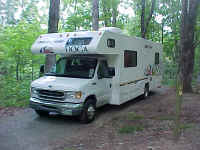 The SS Creaks and Groans docked in the national forest (we recommend docking
bay #19, as one side faces the forest)
The SS Creaks and Groans docked in the national forest (we recommend docking
bay #19, as one side faces the forest)
Once we hit the road, we decide to stop at the
Blue Springs Caves. Apparently, this part of Indiana is just riddled with caves
(there were brochures for at least a dozen cave attractions in this area). We
chose Blue Springs because it is a "wet" cave, which means we get to
ride around in little boats, instead of stumbling around in the dark and hitting
our heads on cave features..
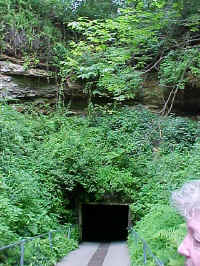 The entrance to Blue Springs caves
The entrance to Blue Springs caves
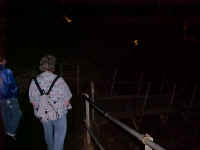
Laura and TJ (our guide) make their way down to the boat
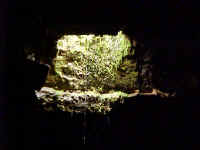
A cave feature (up above, this would be called "a hole in the
ground," down here, it's called "a hole in the ceiling")
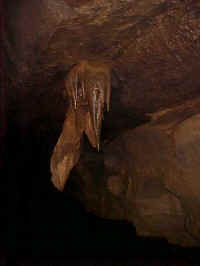
A stalactite; the part on the left is "dead" because people touched
it in 1974 and left greasy fingerprints and now the water just rolls off the
rock instead of making more stalactite
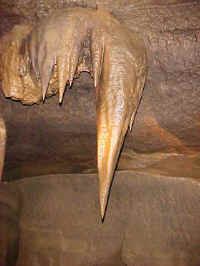
Another stalactite (no shortage of stalactites here, folks!)
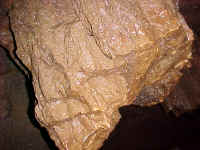
They blasted away part of this stalactite so that boats could get through
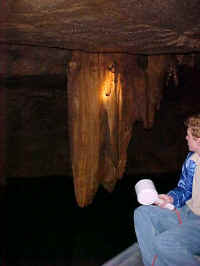
The "Elephant Ear" formation and TJ (TJ's on the right) [Whenever we
passed another boat TJ tried to convince the guide to go with him on a trip he
was planning to a remote part of the cave. "It'll only take six hours to
get there!" He met with little enthusiasm from the other guides.]
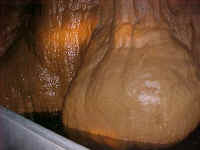
A blobby formation (aka, a stalactite that needs to go on a diet) [or maybe a
stalagmite? hard to tell where that baby begins!]
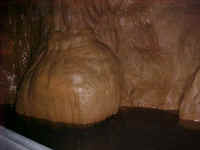
Another blobby formation (or maybe the same one--it's hard to tell them apart)
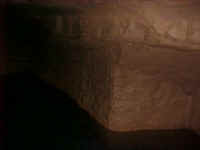
The Quarry Room; the right angles are natural, not man made
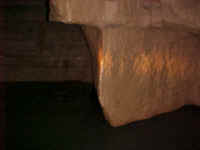
Quarry room
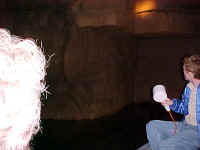
Laura and TJ look at a rock that probably won't fall on our heads, despite the
large crack along the top
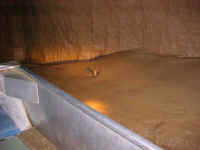
A survey marker set in the "glacial mud" (it's not really glacial
mud, it just looks like it)
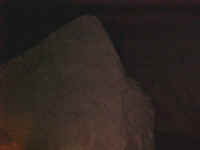
You can just make out the "Rock of Gibraltar" here
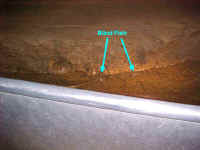
You can see a "blind fish" in the middle near the edge of the water
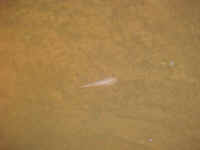
Blind fish; these fish have lived underground for so long that they no longer
have eyes or skin pigmentation
After visiting the caves, we drive on to
Bloomington, where we eventually find the Mathers Museum. We found a reference
to this place somewhere on the web, which is good, because it's not mentioned
anywhere in any of our travel guides. The roads near it are narrow, and full of
construction (lots of fun in an RV), but eventually (with the help of a friendly
University of Indiana guard, who'd also never heard of it) found the place.
It's a small museum that's kind of about science, but it has some cool exhibits,
and a wonderful museum gift shop.
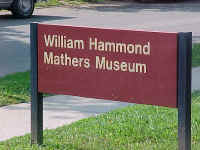 The sign for the museum
The sign for the museum
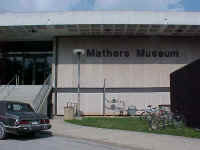
The entrance to the museum
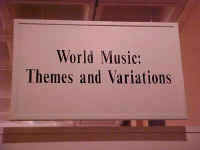
One of the two exhibits we saw
The first exhibit we saw was about musical instruments. They had some old
instruments, and some new ones.
They also had some autoharps (which Laura plays--remember back on Day
3 when we waited for about 40 days and nights for our RV and Laura killed
time playing the autoharp?). They had an interesting thing about the history of
autoharps:
In the latter part of the 19th century, with the rise of
the middle class, it became fashionable to have music in the home, especially
in the parlor, the room set aside for formal occasions. Pianos were preferred,
but not everyone could afford a piano, nor did everyone have musical
abilities. It was this void that the parlor instruments were intended
to fill. These inventions, allegedly easy to play, were sold either
door-to-door or through mail-order catalogs.
The autoharp, invented in the 1880s, was one of the
first parlor instruments. Really a zither, the autoharp uses felt pads to
dampen all but the strings of the desired chord. Melodies can be played by
alternating the chord bars in sequence.
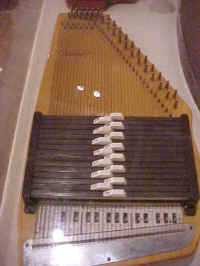 An early autoharp (note the lack of a sound hole)
An early autoharp (note the lack of a sound hole)
There was also a "Player Organ" (like a player piano, but an organ).
Aeolian-Hammond Electronic Player
Organ
Patented in 1938, the Aeolian-Hammond player organ used
a pneumatic system which activated the note when a hole in the music roll
uncovered a hole in the tracker bar. Even though this is an
"automatic" system, individual music effects had to be hand-entered
following instructions printed on the rolls. Only about 210 of these units
were made.
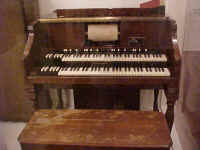 Aeolian-Hammond Electronic Player Organ
Aeolian-Hammond Electronic Player Organ
There was even a record player! And we learned why many popular songs are about
three minutes long...
Record Player
The flat disk record player was introduced in the late
1910s, and quickly superseded the cylinder player. In addition, advances in
electronics brought about the electronic amplifier, which eliminated the
acoustic horn of the cylinder machine. However, the cylinder machine did have
a lasting effect upon popular music; since cylinders could only hold about
three minutes of music, that was the effective upper limit to songs. Even
though a 78 revolutions-per-minute (rpm) record could hold more sound, that
three-minute limit was maintained, even after the introduction of the
"long-play" 33 rpm in 1946 and the 45 rpm in 1947.
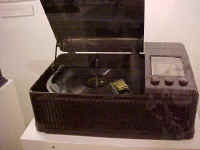 Philco combination record player and radio from the late 1940s
Philco combination record player and radio from the late 1940s
The museum also had a bunch of music jokes. Here's some of them:
Musicians and Music
- What does New Age music sound like played
backwards?
- New Age music.
- What happens when you play the blues backwards?
- Your wife comes back to you, your dog returns
to life, and you get out of prison.
- What would a musician do if he won a million
dollars?
- Continue to play gigs until the money ran out.
Bagpipes
- What's the hardest thing about learning to play
the bagpipes?
- Knowing when you've made a mistake.
- Why do bagpipers walk when they play?
- To get away from the noise.
- Did you know the Irish invented the bagpipes as a
joke?
- The Scots haven't got it yet.
The American tourist walks up to MacGregor who is
playing the pipes and she says, "Maybe it you stop squeezing it, it
will stop screaming!"
French Horn
- How do you get your viola section to sound like
the horn section?
- Have them miss every other note.
- How can you make a trombone sound like a French
horn?
- Stick your hand in the bell and play a lot of
wrong notes.
- What do you get when you cross a French horn
player and a goalpost?
- A goalpost that can't march.
- What's the difference between a French horn
section and a '57 Chevy?
- You can tune a '57 Chevy.
- Why is the French horn a divine instrument?
- Because a man blows in it, but only God knows
what comes out of it.
Piccolo
- How do you get two piccolos to play in unison?
- Shoot one.
Trombone
- What is a gentleman?
- Someone who knows how to play the trombone but
doesn't.
- What is the difference between a dead trombone
player lying in the road and a dead squirrel lying in the road?
- The squirrel may have been on his way to a gig.
- How do you improve the aerodynamics of a
trombonist's car?
- Take the Domino's Pizza sign off the roof.
- How do you tell which kid on the playground is the
child of a trombonist?
- He doesn't know how to use the slide and he
can't swing.
- What is the dynamic range of a bass trombone?
- On or off.
It's difficult to trust anyone whose instrument
changes shape as he plays it.
- What's the difference between a bass trombone and
a chainsaw?
- 1. Vibrato, although you can minimize the
difference by holding the chainsaw very still.
2. It's easier to improvise on a chainsaw.
Piano/Keyboard
- Why are a pianist's fingers like lightning?
- Because they rarely strike the same place
twice.
- What do you get if you throw a piano down a mine
shaft?
- A flat miner.
- What do you get if you drop a piano on an army
base?
- A flat major.
- Why is an 11-foot concert grade better than a
studio upright?
- It makes a louder noise when you drop it off a
cliff.
- Why was the piano invented?
- So the musician would have a place to put his
beer.
Harp
- How long does a harp stay in tune?
- About 20 minutes...or until someone opens a door.
- Harp players spend half their time tuning their
instruments and the other half playing out of tune.
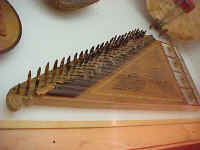 A zither (note the difference between a "zither" and an
"autoharp": no pushbuttons on a zither to
"auto"matically make chords)
A zither (note the difference between a "zither" and an
"autoharp": no pushbuttons on a zither to
"auto"matically make chords)
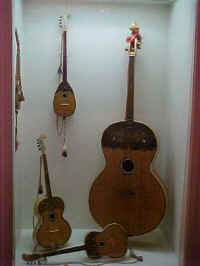
A herd (fret?) of guitars
After we looked at all the musical instruments, we went to the next exhibit, Technology!
They picked a different technology for each letter and then kind of did a riff
on it. It ended up yielding some interesting exhibits (and some dull ones,
too).
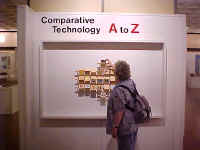 The opening to the exhibit (turn over the letter block to see what it stands
for)
The opening to the exhibit (turn over the letter block to see what it stands
for)
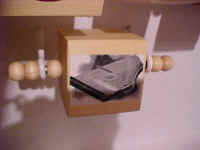
Letter block "Z" is for Zither
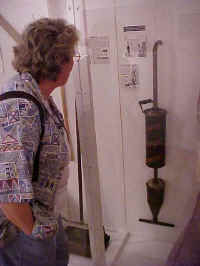
"B" is for Broom; Laura examines an early vacuum cleaner and
wonders where you put the coal
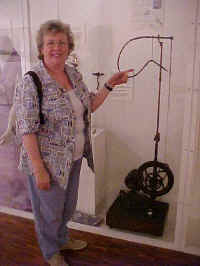
"D" is for Dentist's Drill; Laura contemplates having her teeth
drilled by this thing
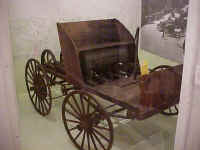
We cannot imagine doing this trip in something even remotely resembling this
thing; those hearty pioneers really did have buns of steel!
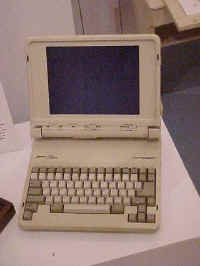
"I" is for inkwell; an advanced inkwell, but very old
technology (a 1990 laptop!)
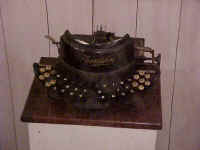
A very early typewriter (it still uses something resembling the modern
keyboard arrangement, though)
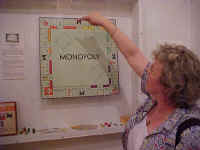
Laura points to Indiana Avenue (hey--we're in Indiana!); a very
basic kind of map
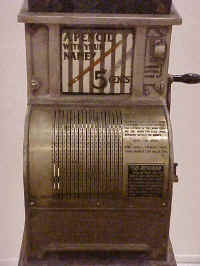
"V" is for Vending Machine; too bad this one doesn't work, we
wanted a pencil with our name on it!
"Z" is for Zither
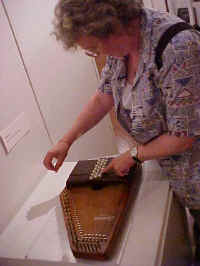
"Z" is for Zither; Laura checks out the autoharp
The museum had this to say:
The basic problem with zithers is that it is difficult
to play chords of more than a few notes. The autoharp was invented in the
1880s as a technological advance on zithers. Pressing down one of the chord
bars forces strategically placed pieces of felt against certain strings,
effectively dampening them, so that only the notes of the desired chord are
sounded. Depending upon the size of the autoharp, full chords of ten notes
can be sounded.
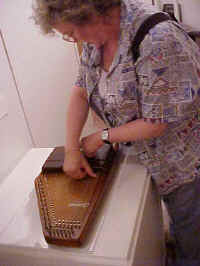
This autoharp is, of course, out of tune
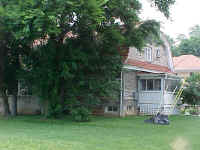
Right outside the museum is a stone barn
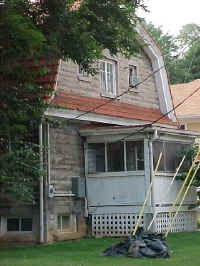
We don't think the air conditioning is original equipment
We spent a lot of time (and about $90!) in the museum store. The museum lady
was very nice, she said, "This store is made for playing in, so be sure
to play in it!" She even came back and showed Robert how to ring the gong
so it was extra loud (Laura stepped out during this demonstration). They had a
lot of stuff from other countries, and all the prices were pretty cheap.
Then we headed up to Indianapolis, planning to camp at Camp NothingMuchHere.
When we finally found Camp NothingMuchHere (at the end of a number of small,
narrow roads), we discovered it should have been named Camp
NothingHere, as it was closed! Yikes! We stumbled our way back to
civilization (since we couldn't turn around, we had to negotiate back roads,
half of which were closed for construction) and eventually found a campground
with three spaces left (whew!).
This is kind of a drawback to RVs. There's more motels in civilized areas than
there are campgrounds.
|














